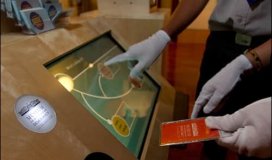Tokyo's St. Luke's International Hospital has completed a pilot of RFID technology to track the movement of equipment. The facility found that the technology identified stock levels at each of its wards in real time, and reduced the number of staff visits to the central clinical engineering room by approximately 55 percent. The technology, known as Recopick, is provided by Japanese carbon-fiber and plastics technology company Teijin Ltd.
St. Luke's serves approximately 2,550 outpatients daily and has 520 beds for patients staying at the facility. It includes 13 floors and a total of 60,000 square meters (646,000 square feet) of facility space in its main building The hospital is growing with the demands of its community; recently, it added an annex and birth clinic containing 19 beds.
Much of the hospital's equipment used to treat patients, such as infusion pumps, syringe pumps, low-pressure continuous suction devices and oxygen flow meters, was stored in centralized clinical engineering rooms when not in use. This meant that employees seeking equipment had to walk to and from these centralized rooms many times during each shift. To create a record of which personnel took which items, the hospital used a bar-code system so that workers in the engineering rooms could scan each asset as a nurse borrowed or returned it. Because this process was so time-consuming, nurses often kept medical devices in their own wards so that they could easily access them again. For the hospital, that meant the items appeared to be missing, and stocks were thus replenished unnecessarily.
St. Luke's began seeking a better, more automated solution in 2016 and deployed Recopick in the spring of that year. About 1,300 pumps and oxygen flow meters were tagged with passive ultrahigh-frequency (UHF) RFID tags with a waterproof casing, so that they could sustain cleaning and sterilization processes.
All shelves in the medical engineering center, as well as throughout 22 wards, were retrofitted with Recopick RFID-enabled sheets that are laid over each shelf, says Natsuki Aramoto, the company's team leader of new application development for smart sensing. Tagged items are placed directly onto those sheets, he explains. Each shelf unit comes with a Convergence Systems Ltd. (CSL) CS468 reader and Teijin's proprietary antenna sheet to capture tag ID numbers.
The readers forward the collected data to software, indicating which specific item is stored on which shelf. Recopick also provides RFID-enabled disposal units so that users can view what has been discarded. The engineering room shelves are divided into two categories: those on which devices are awaiting cleaning and maintenance after being returned by a nurse, and those that have been serviced and cleaned and are ready for reuse.
When the hospital tagged its equipment, data about each item was input into the software and stored along with the unique ID on that device's tag. The information is stored and interpreted by the Recopick software residing on the hospital's server.
When a nurse takes an item from the engineering room, he or she can simply remove it, and the software will then update its status accordingly. If the tag is not read for more than 120 minutes, its status is again updated as "in use," under the assumption that it is being utilized on a patient. The equipment could be placed on a shelf within another of the 22 wards, at which time the software would be alerted that the device was being stored at that location.
After the device is used on a patient, the staff member returns it to the engineering room for cleaning and maintenance. He or she can simply place it on the receiving shelf, and the software will thus be updated. The engineering staff cleans the asset and places it on the cleaned and maintained shelf, and the software will thereby know that the equipment is ready for reuse.



